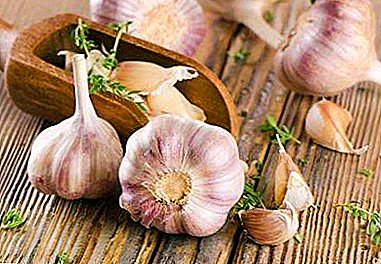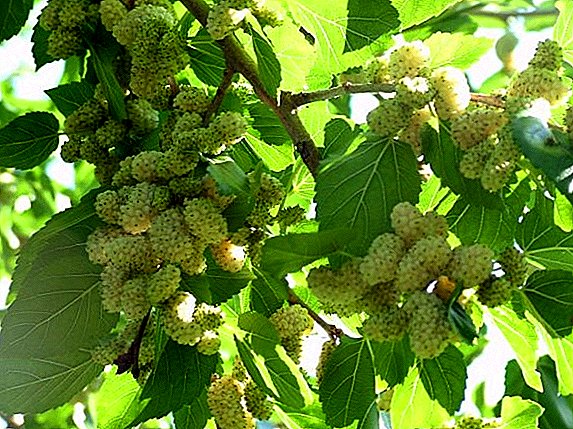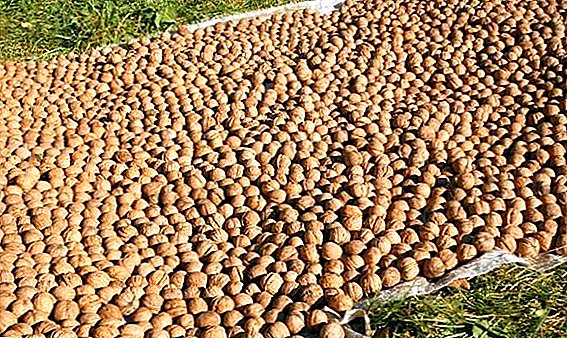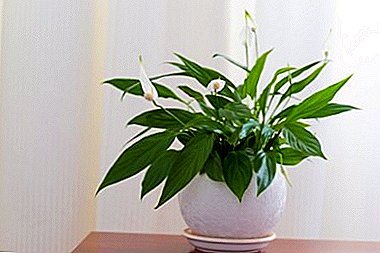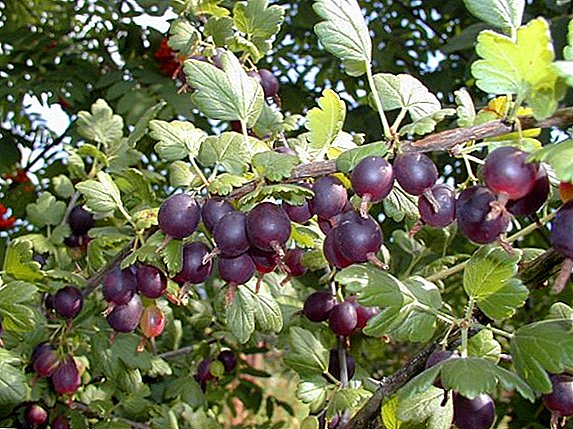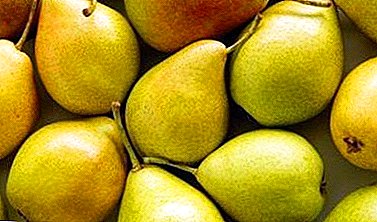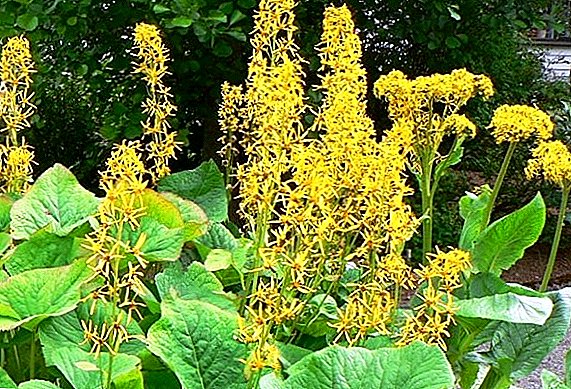 Buzulnik - perennial, which has recently become increasingly popular. The plant has beautiful flowers and leaves, it is used in single and group plantings. Since the plant is high (up to two meters), it can decorate the unsightly wall of a building or serve as a screen.
Buzulnik - perennial, which has recently become increasingly popular. The plant has beautiful flowers and leaves, it is used in single and group plantings. Since the plant is high (up to two meters), it can decorate the unsightly wall of a building or serve as a screen.
Site selection and soil preparation
Buzulnik does not like direct sunlight, under their influence the flower fades, losing moisture. For cultivation in the garden is better to choose a plot with penumbra. At the same time, the soil should be loose and keep moisture well, otherwise the plant will develop poorly, and flowering will be poor and inexpressive. The best option - a shady area near the reservoir, possibly artificial.  Buzulnik is a tall plant, so a place for it must be protected from the wind, so that the long branches of the plant along with the peduncles will not break due to strong gusts of wind. Buzulnik is not afraid of heavy soil structure, if it is fertilized and moistened properly. Before planting, they dig up the soil to the depth of the spade bayonet, introducing humus. The choice of location should be taken seriously, because the buzulnik in one place can grow up to twenty years.
Buzulnik is a tall plant, so a place for it must be protected from the wind, so that the long branches of the plant along with the peduncles will not break due to strong gusts of wind. Buzulnik is not afraid of heavy soil structure, if it is fertilized and moistened properly. Before planting, they dig up the soil to the depth of the spade bayonet, introducing humus. The choice of location should be taken seriously, because the buzulnik in one place can grow up to twenty years.
Planting a seed box
Reproduction of a buzulnik by seeds occurs also by self-sowing, if the seed has had time to ripen and has fallen into fertile soil.
Seedling method
Seedlings are sown in seedlings in January or March, depending on the varietal characteristics. Sow the seeds in the seedling box, shallow. Sprinkle with soil and put in a warm place with ambient lighting. Caring for seedlings is to moisten the soil. Grown up and grown up shoots are planted on the site in May.
Did you know? Ligularia (scientific name of a buzulnik) is translated from Latin as a diminutive of "language", since almost all species have a tongue-shaped petals.
Sowing seeds in open ground
 Sowing seeds in open ground is carried out when there is no threat of frost, although the best time for sowing is considered to be sowing in November before winter. During the winter period, the seeds undergo stratification under natural conditions, seedlings are considered more viable. In any case, the depth of sowing - centimeter. If you sow in spring, make sure that the soil is always wet. Buzulnik, grown from seeds, blooms no earlier than the fourth year.
Sowing seeds in open ground is carried out when there is no threat of frost, although the best time for sowing is considered to be sowing in November before winter. During the winter period, the seeds undergo stratification under natural conditions, seedlings are considered more viable. In any case, the depth of sowing - centimeter. If you sow in spring, make sure that the soil is always wet. Buzulnik, grown from seeds, blooms no earlier than the fourth year.
Transplanting and dividing a bush
As the plant grows in one place for a long period, it should be rejuvenated once every five years: divide and replant. Buzulnik, growing, strongly expands, its root system forms many shoots interfering with each other. The transplant procedure is best done in the spring, at which time it is easier for the plant to take root in a new place. In addition, in the early spring, before the development of the kidneys, the buzulnik has the opportunity to spend strength and nourishment for adaptation.
Important! Buzulnik is difficult to survive and recover after a transplant. At this time, pay close attention to him. The adaptation period lasts about a month.
 When dividing a bush, you do not need to dig out the entire bush: separate part of the bush with young shoots and carefully dig him. Cut into several suitable for planting, having dormant buds of seedlings. Treat the cuts with potassium permanganate. Prepare for saplings a hole about forty centimeters deep at a distance of one and a half meters. When planting buzulnika put on the bottom of the hole half a bucket of humus, a handful of wood ash and superphosphate. Plant, straightening the roots, sprinkle with soil and pour.
When dividing a bush, you do not need to dig out the entire bush: separate part of the bush with young shoots and carefully dig him. Cut into several suitable for planting, having dormant buds of seedlings. Treat the cuts with potassium permanganate. Prepare for saplings a hole about forty centimeters deep at a distance of one and a half meters. When planting buzulnika put on the bottom of the hole half a bucket of humus, a handful of wood ash and superphosphate. Plant, straightening the roots, sprinkle with soil and pour.
The mother bush also needs to be watered by filling up the hole left after division. Over time, the plant will spread the root system in the vacated space.
The combination of a bush with other plants
Buzulnik in landscape design goes well with hosts, daylilies, highlander snake, soft cuff. The plant has large leaves with an interesting pattern; tulips and primroses look vividly and more expressively against their background in the spring. Bouzulniki are well combined with plants that have the same growing conditions, for example astilbe, bruner, basil, darmer, groundwort, rogers, melluna, badany and others.
 Yellow inflorescences of buzulnik form an interesting contrast with blue delphiniums and purple aconites. You can create screens from the buzulnik, protecting certain areas, the height of the plant allows it. You can plant around a pond in a semicircle, use the flower in a single planting, as the central figure.
Yellow inflorescences of buzulnik form an interesting contrast with blue delphiniums and purple aconites. You can create screens from the buzulnik, protecting certain areas, the height of the plant allows it. You can plant around a pond in a semicircle, use the flower in a single planting, as the central figure.
Interesting! In addition to decorative purposes, the bouzulnik is also grown for medical needs. Buzulnik gray helps to cure alcohol dependence. It is possible to avert a drunkard from addiction by using the root of a plant.
Care for the perennial buzulnik in the garden
Buzulnik unpretentious, care for him in the open field does not require botanical skills. During the period of active plant growth, it is desirable to loosen the soil and mulch the stem to better retain moisture.
Regular watering
Buzulnik is a moisture-loving plant, in summer, especially with active sun and insufficient rainfall, watering should be frequent. Watch the condition of the soil. If the air is too dry and hot, spray the plant.
Buzulnik's fertilizer
 Organic matter is recommended as fertilizer - mullein infusion (1:10). Feed a buzulnik once every two weeks under a bush; three liters are enough for one plant. In the fall, half a bucket of humus is introduced into the soil, trying not to get to the roots.
Organic matter is recommended as fertilizer - mullein infusion (1:10). Feed a buzulnik once every two weeks under a bush; three liters are enough for one plant. In the fall, half a bucket of humus is introduced into the soil, trying not to get to the roots.
Attention! It is not recommended to feed the plant with sudden temperature changes. This may affect development and appearance.
Garter plants
Buzulnik grows high, when flowering it may need support. Although the branches of the plant are quite flexible, the wind can break them, especially under the weight of the inflorescences.
Pruning inflorescences
Bouzulnika flowers are cut after flowering, if you need seeds, leave a couple. Pruning is done so that the nutrients go to the leaves and branches, and not to the flowering inflorescences, so that there is no planned self-seeding. The plant will increase its deciduous mass before wintering.
When to collect and how to store the seeds of the brushwood
In order to correctly collect the seeds and not wake up on the ground, wrap the flower with gauze before it blooms. After the plant has flowered cut off the wrapped inflorescences. Above a sheet of paper, expand the gauze, shake off the seeds, sort out from dry petals and dust. When sowing before winter, spread the seeds on paper and leave until the procedure itself.
If you plan on sowing seeds of a buzulnik in the spring, dry them on paper and put them in a fabric or paper bag. 
Wintering perennial buzulnika
Buzulnik tolerates cold. But, if the winter is without precipitation or with periodic thaws, the plant may die. To avoid this, the above-ground part of the flower is cut almost to the root, the site is mulched. For your own peace of mind, you can cover with spruce leaves or covering materials.
Pests and diseases of the botulnik
Surprisingly, insects bypass these shade-loving country flowers. What can prevent a plant is slugs. They love to eat young leaves. Usually, in order to discard the slugs, at the site scattered beaten walnut shells or superphosphate granules. Diseases of the plant is also not subject, the exception is powdery mildew. She can attack the buzulnik, but it is easy to get rid of her. Option one: spray with a solution of colloidal sulfur (one percent); option two: mustard powder or soap solution.
All that the bouzulnik needs is regular watering and maintenance; in the fall, pruning of the inflorescences. This is a universal plant for landscape design, thanks to the decorative appearance of the leaves, the plant adorns the garden both before and after flowering. The same can be used to cover the unsightly economic structure or neglected part of the garden.


